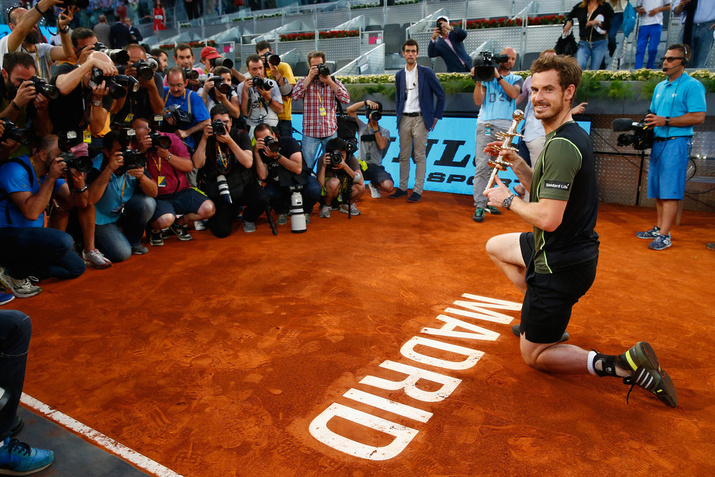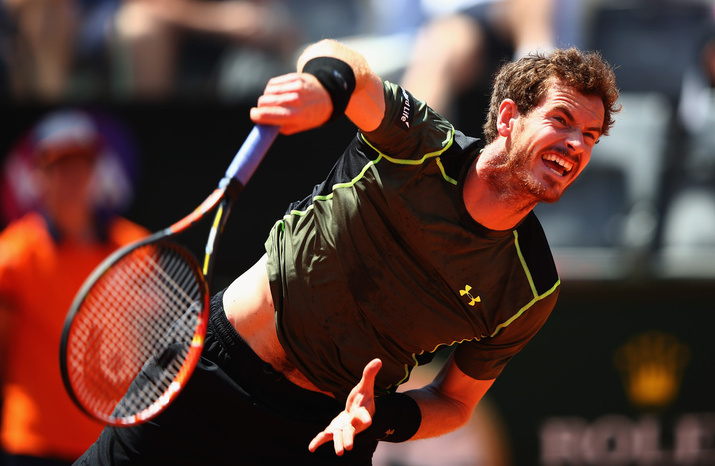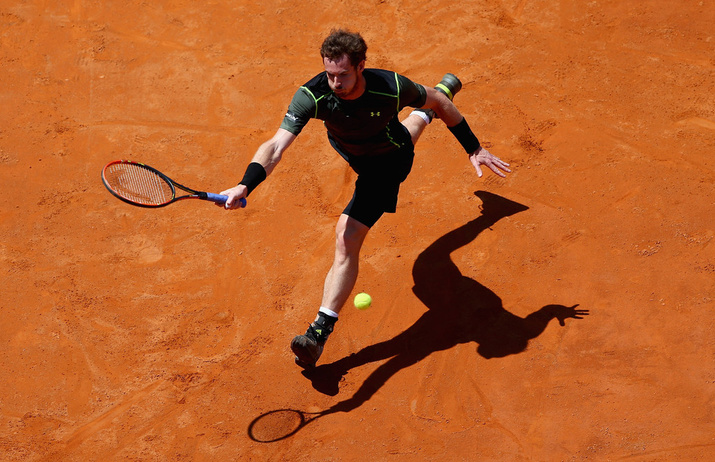Don't miss any stories → Follow Tennis View
FollowWhy Andy Murray's Clay Success May be Limited
When Andy Murray won the clay ATP 250 event in Munich as the No. 1 seed, beating home player Philipp Kohlschreiber in the final, it did not make you sit up and notice, even if it was on his least favorite surface.
The more remarkable fact was the little snippet of information that invariably complemented the reporting of Murray’s win: that this was not only the world No. 3’s first clay title, it also came in his first final on the surface.
And if that fact took you by surprise – as evidence of the superb Scotsman’s decade-long difficulties on the dirt – the feeling can only have been reinforced after Murray backed up his win in Germany by going all the way last week in the Masters 1000 event in Madrid. After defeating a half-injured Milos Raonic and last year’s finalist, Kei Nishikori, Murray capped his run off in spectacular fashion, putting away a very nervous-looking Rafael Nadal, 6-3 6-2.

After having never even participated in a final on clay, Murray won two events in little more than a week – the second of which is one of the most prestigious events on the surface on tour. From having won just one match on clay against a top -10 player during his whole career, Murray has now won three straight matches against fellow members of the top 10.
Undoubtedly, he has found a new level in his clay-court game, a caliber of play on the surface he has never reached before. Looking in from the outside, the improvement seems to have come from a combination of a greater understanding of how to tweak and alter his game on the surface, and of the mentality needed to succeed on clay.
Also, this development raises the question of why Murray actually has struggled so much and for so long on clay in the first place, when his playing style and strengths should match the characteristics of the surface. And is this sudden upturn of form signaling something permanent, or will he fall back into old habits again?
As everyone reading this will know, the clay courts are the slowest of the surfaces. As such, they reward more defensive qualities, such as baseline consistency, tactical ability, and good movement, rather than pure attacking power. You can hit through your opponent on the slower clay as well, but it requires an extremely high level of force and precision, and to do it for a whole match is a very tough ask even for the best players in the world. Instead, patient rallying and smart maneuvering are key components to be successful on clay.
On paper, it sounds like a brand of tennis tailor-made for Andy Murray. He is an expert defender, strategist, and counterpuncher, adept at reading and breaking down his opponent and varying his own game. Barely anyone in the sport is capable of matching the Scot in terms of movement and stamina. Throw in consistency on both groundstrokes as well as an unquenchable thirst to grind and fight and win, and it sounds like the complete clay package. Even his weaknesses (apart from his difficult temperament) fit the description: a slight lack of attacking power, an inability to simply hit through his opponents, and shortcomings in serve and forehand.

But as Murray said himself, when discussing the issue in some detail in the Guardian a few years ago, ”It’s not a surface that comes that naturally to me,” adding that he ”needs to spend a lot of hours on the practice courts getting used to it.”
Tennis is a mental sport, and few embody that fact quite like Andy Murray. When analyzing the Scot’s game, his distinctively sarcastic, often frustrated on-court personality is never far away.
Indeed, in the Guardian interview, Murray latched on to the mental side of things himself, in relation to his struggles on the surface. He said that ”clay is probably mentally one of the toughest surfaces,” explaining that ”on the clay patience is very important.”
Mats Wilander was also on to mental issues when addressing the topic for the BBC back in 2012. The game is all there, the Swede argues, and the problem has always been in the head: “Andy's problem on clay is that he hasn't matured enough in that mental department where he is willing to ask questions over and over.” In this special brand of tennis, “you get on a roll for 20 minutes, and you run into a problem and your opponent figures you out.”
It’s true that part of the problem Murray has had on clay is a mental one. Having said that, I would argue that the real sticking point is a technical one. While Murray, with his wide range of talents, has the potential to be far more successful on clay than he has been up until now, his game is still best suited to the quicker surfaces. This is where he will continue to produce his very best performances.
When discussing different surfaces, it is easy to conclude that all of the more offensive players favor the quicker surfaces that reward their attacks a little more, and all the defensive players thrive on clay. But the reality is more complicated than that. Take for example the fact that some of the most aggressive ball-strikers actually play their best tennis on clay, Maria Sharapova being one obvious example. The slower bounce of the ball on clay makes it easier for them to arrive to and time the ball, and enables them to play more of their best attacking shots.

The same kind of reverse logic applies to defensive expert Andy Murray, and his success on the quicker, attack-oriented surfaces. Moving and defending as well as he does – reading his opponents and running almost every ball down – is something almost unique on the faster courts: a world-class weapon. This is especially true on the grass courts, where he thrives but a lot of seasoned pros spend half of their time slipping and sliding. On the slower clay courts, a lot of players on the Tour can move and defend well enough, dampening Murray’s ”competitive advantage” in this area.
The weakest point in Murray’s game is his inability to generate serious pace on the ball. But you would not notice it if you were watching him on form, on a quicker surface. There, instead of blasting the ball himself, he can use the pace of his opponent’s ball as it drives through the court to hit though his opponent. If you want an example of what I mean, watch some highlights of Murray from Wimbledon 2012 or 2013. His forehand is so explosive it is almost unrecognizable from the almost laborious one we can see on slower surfaces. When playing on clay, where automatically there is less pace on the opponent’s ball, Murray’s struggle to generate his own attacking power from the baseline is much more obvious.
On quick surfaces, Murray’s gets the most out of his strengths, while he can use the surface speed to mask his weaker points. On clay, it is the opposite scenario: his best qualities stand out less, and he cannot tackle his weaknesses in the same way.
It is great news that Andy Murray, around his 28th birthday, suddenly seems to have taken a significant leap forward in his clay game. He has the assets to be decidedly more successful on clay: winning more titles, reaching more finals, beating his rivals at the top more regularly, and generally being more competitive week in week out. Having said that, all the evidence points to only one thing: that Murray will continue to post his very best results on grass and hard courts.










